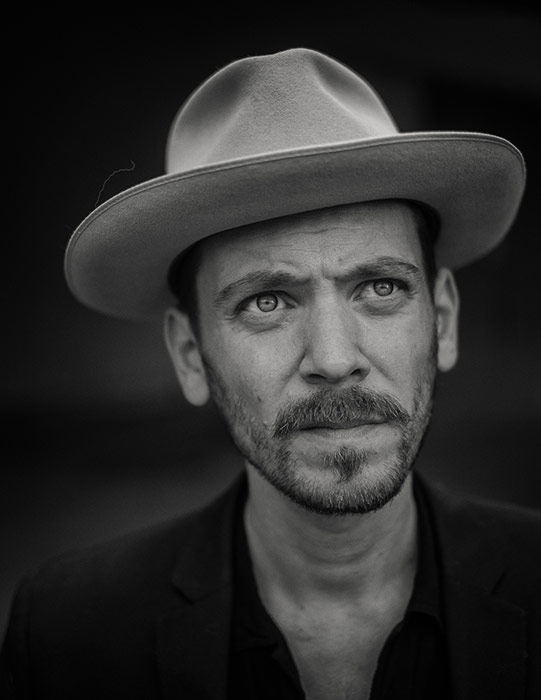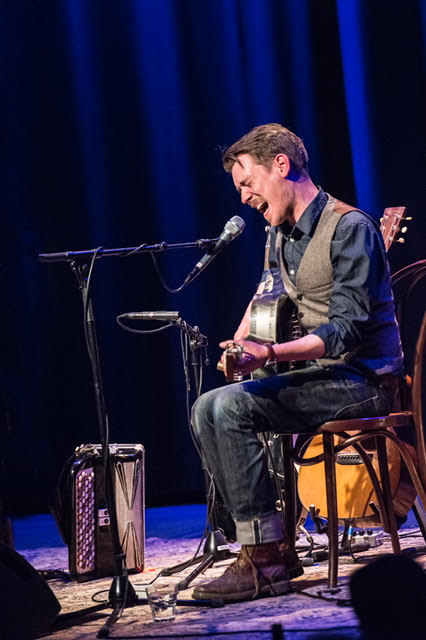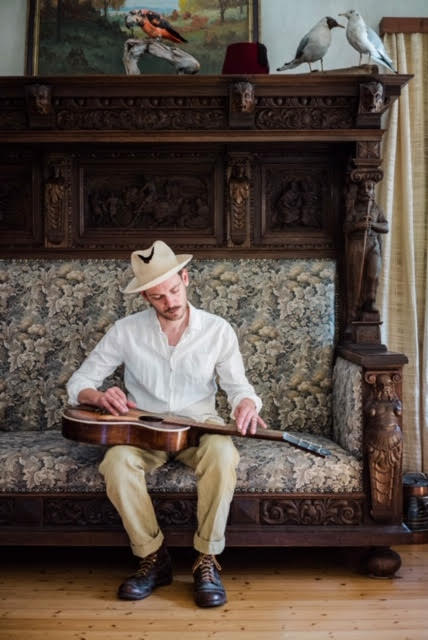By Johnny Petersen
Editor’s Note: Oct. 2022. Our Scandinavian correspondent Johnny Petersen is back from a rather serious medical issue and we joyfully celebrate his return as an important contributor. He has his finger on the pulse of the vibrant roots & blues acoustic scene in Scandinavia. Here he puts the spotlight on an amazing player who most international blues fans might otherwise miss, but who is quite astonishing and amazing. The editorial policy of thecountryblues.com is based on the ideal of musical universalism. We endorse anyone to play anything they feel in their heart and soul, provided that they respect the origins and traditions of the blues as an African American art form of oppressed and subjugated people, that they respect the original players and that the blues are rooted in the suffering of a people. In the same way that we celebrate people of Asian and African origin to play classical music in the major world philharmonic orchestras, we cheer the beautiful players who perform acoustic blues, no matter where they are. If they are good, we want it, and wow, Svante Sjöblom is good, with one foot in Americana and the other in acoustic roots blues. This guy could hold his own against the most famous players in the genre, and we cheer this exposure by Johnny Petersen. Check him out and rejoice.
”A country boy in…” no, not New Orleans but Malmö, twin city of Copenhagen and capital of Southern Sweden.
38 years old Svante Sjöblom has been a very popular acoustic guitarist, both in Sweden and Denmark, for quite some years now – although he is still seen as that “Young Slim Swede” (Peter Nande) – always filling the venue with his ardent fans.

He is seen as a true guitar virtuoso, capable of playing almost any genre with short notice, on almost any stringed instrument, even if he doesn’t recognize such a description. He started out with a deep dive into the acoustic blues scene and its foremost proponents. Already at the first encounter with him one is blown away and he really deserves to be known and appreciated abroad as well. It’s he’s deep soulful voice together with his mastery of the strings that directly touches one’s heart! Lately he’s been exploring and combining the blues with the more folksy country-style traditions of the U.S.
When asked to describe his first staggering steps into the world of music he tells us, “I began playing drums when I was 11 years old, the classic scene when you play on pots and pans, no it must have been much earlier, like when I was four or something. We had lots of music at home as my dad was a keen listener and record collector. When I was 11 years old, we bought a used drum kit from an ad in the paper. A little later I had the notion that I really wanted to play guitar. I didn’t play this wooden flute that the other kids did in the music class so then I would begin to play electric guitar, directly. And so I did, we bought an electric guitar when I became 13 years old. To begin at this early age is a valuable thing because that time you will never have again. The time when music gets into the bone marrow. That period between 11 and, say 19, I didn’t do much else than playing. I’m not a practice person so to speak, but I rather learn from playing the real stuff. I just have too little patience, so I learned from doing it my way. Some friend of mine do practice every day and finds a joy in that but I don’t. Even if I were to dispose all my time with music, I know I would not do that. I’m dependent on the contrasts between music and other things I do. I’m a trained furniture carpenter and I just need to do that and other things in order to keep up my joy in making music. Then there comes a longing for playing the guitar and I can sit down and create something new. I was simply allowed to do it my way. When I was 14 years old, I had found some other kids who liked to play and we formed our first band. Then we began gigging and that I’ve been doing ever since.”
Q: “I don’t know who, maybe it was you yourself that once told me that the keyboard player and record producer Magnus Nörrenberg had a great impact on you. Please tell us about that.”
SS: “I met him for the first time when I was 17 years old at ‘Bullen’ (The Bulls Eye – a local pub) where my dad used to go on Thursdays and listen to him and some other local musicians. So my dad brought me there. I was studying music in High School by the time. And soon enough I was invited to play as a guest. I didn’t know them at all but they thought I was fun so they asked me to come back. I came back with my old acoustic Levin guitar and Magnus said with a growl, ‘I do hope you have old strings on that thing’, and then he left. I was afraid of him for quite some time after that.”

“But then we recorded my first CD together in my house. After that we have occasionally played together with other artists. It’s been 20 years now. He has recorded all of my CDs, the last one took almost two years during the pandemic. I do trust him fully. When we record, we move all his equipment down to my house in the countryside because I don’t like the environment in a studio. I prefer to work at home, it’s more relaxed. You can take a break and walk down to the sea if you like, or have a coffee in the garden. I have slowly accepted it as being studio-musician but I do prefer a living room. Just to be able to hang out, maybe light a fire in the stove and… It’s really important with the social setting and the contact between the people I’m playing with. I am not a city guy; I am a real countryman. And he accepted that. Eventually maybe you must let that go. Now we have finished the latest CD and kinda drained it. So, maybe it’ll have to take some time and then we’ll see what happens.“
Next question: “What was your early inspirations?” “Bob Dylan maybe?”
SS: “Well, my first records where Nirvana and Guns ‘n Roses. Grunge was the thing in those days. My father has collected records all his life and he made some Mix Tapes for me with a wide array of music. Dylan, ELP, Zappa and Leadbelly just to mention a few. Then Hendrix of course, my first electric guitar inspiration. Hendrix was IT. But I was jumping around, John Lee Hooker was one inspiration. And then there was Fjellis (a local acoustic blues master, playing an old National). Then I began checking out the songs he had recorded and where they came from. There I found Robert Johnson and Bukka White among others. That way it was from I was thirteen until I was sixteen, then I dived into the acoustic world. From there it was just Country blues and Delta blues for the next four or five years. I only discovered his music after he was dead, although I did meet him at my friend’s house.”
“Bob Dylan has always been around but he has never been a hero to me. Some people I can ‘hear’ and I just couldn’t ‘hear’ him. Now I can. I do listen to his Christmas record one a year (laughing).”
OK, next one: “How did you get to know Peter Nande?”
SS: “Well I met Peter and Tim Lothar at Åmål Blues Fest where I’ve been playing a lot. And after that I became stand in for Tim in their duo when he was on the road. It began with a single gig and suddenly it became a whole lot of gigs with Nande’s Blues Jamboree. I just went from here to Copenhagen and we did that duo thing and soon after he started the Jamboree sessions and we did that for seven years or so.”
Q: “ It was there you got the nick name ‘The little thin Swede, wasn’t it?”
“Yes, that was bullying on a high level (laughing). I had been listening to all of them like in the Blues Tent at the Malmö Festival. Like Paul Banks and H.P. Lange who was other heroes of mine of course. When I began playing acoustic guitar I looked for and found every single one. So it was really fun to get there and play with them. We were like eleven or twelve people when we recorded the two CDs. After a while I began having that music as a work and I did run overtime. That’s the fact. It ran way too long. I found out that it was not my music so to speak. Not what I had in my heart. My heart contains a mix of everything I’ve been listening too since I was like thirteen. During my education I was playing all kind of things, we had a Frank Zappa Ensemble and we played The Doors who did have a blues connection but on a different level. But the, I’ve always played bluegrass, Irish folk-music and Old Timey music. I can feel trapped – I mean I can make you any piece of furniture you like but I can’t play just anything. Not anymore. I do not say it’s wrong to do that but it’s not for me. That’s not why I’m playing.
I took a break for two years in 2017, prior to the pandemic, so that’s when I stopped playing in Denmark. I felt I was done with that thing. I did play a couple of gigs there in 2017 and a couple of gigs with Paul Banks here in Sweden as well. One was in Kornhult, a place outside Halmstad that is a Danish nest, owned by Danish and a lot of Danish artists playing there. I’ve played there with Twang as well.

Q: “Did you get connected with Twang through Paul Banks (being the father of the banjo player)?”
SS: “Me and my wife Malin booked them to our old country store for a gig. That was just what I needed. They are so damned good. They have the right mixture and a true joy in what they are doing. After the concert we were jamming ‘til four in the morning. Later they played at our wedding. We said,
‘We need to find a reason for playing together, how about us doing a record?’ And so we did. After that we managed to play three gigs and then the whole society were locked down.
Q: “Tell us about your other cooperation’s, like Sophie Livenbrandt – with whom you recently made a record – and others.”
SS: “Well I’ve played with Sophie occasionally for many years, ever since her first record in 2008 or 9. There are no others, I keep away from it. I try to concentrate on my own thing. No guest appearances. Not that I don’t like it but I do need to focus on my own music. I haven’t been able to do that for many years. My song writing is alive now and that’s what keep me alive.
Q: “I have an obligatory question that everyone, ‘Who would you chose to invite over to play with if you could choose freely? Only one.’”
SS: Well, that’s difficult. No, I can’t answer that. That would be to live in something else, wishing you were someone else. I avoid living that way.
Last question: “Tell us about your guitars.”
SS: “That’s Martin for the whole penny. I have three at the moment. Well, I do have four but the one is out for sale, a D-28 from 1960. My mentor in both carpentry and Bluegrass always played Martin so he got me into that. My first Martin I bought from a musician in Gothenburg who had bought H.P Lange’s old one in Memphis, Tennessee. That particular one I don’t have anymore. I’ve been trading some and I’ve played National Reso guitars for many years as well. That’s part of the game, but I tired and felt limited, so I sold them as well. One was an old -29 that I traded for an old Martin. I have a 0018 that I will never get rid of. And a -46 that is just perfect. But now I have switched to playing Dreadnoughts. I have D-18. If I play on that it’s difficult to play a small one, it just doesn’t work.
I have a couple of electrics as well, a Telecaster and a Tobias Lindberg. A guitar that I will never leave as well. It’s mine! (Laughing). But I have never been picky about electrics but acoustic is very different.”